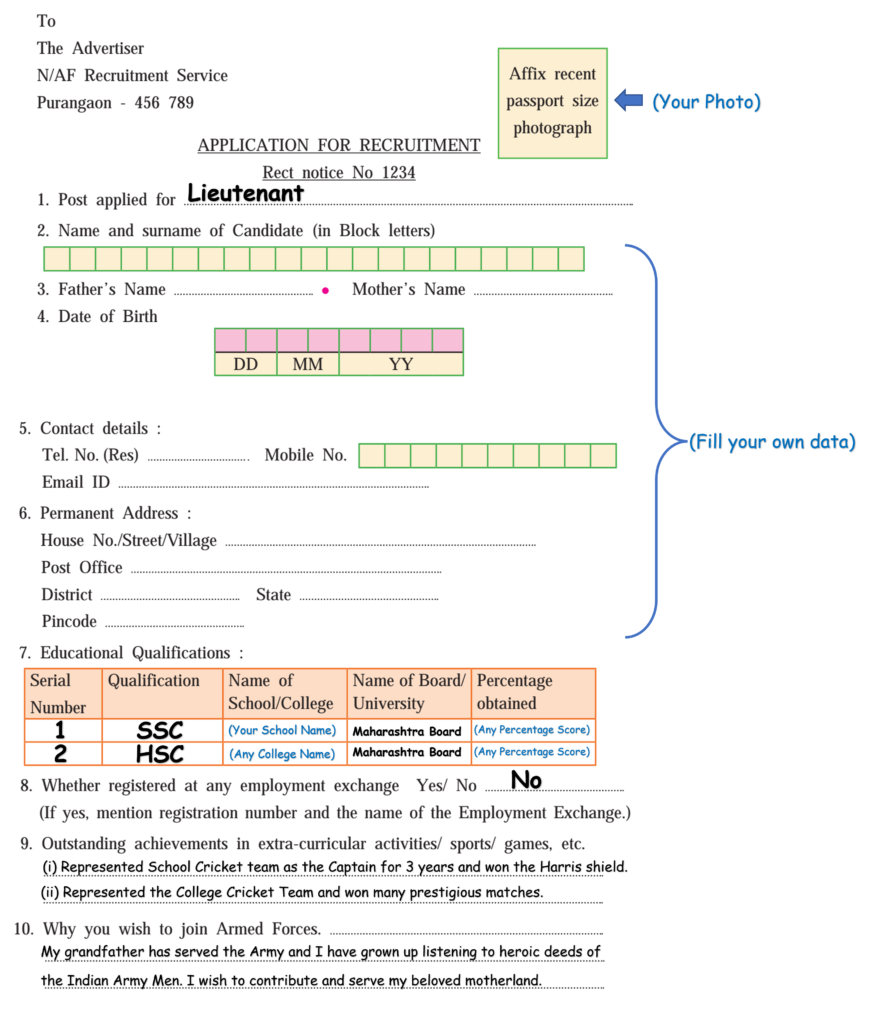
1. The ranks of officers in Indian Army, Navy and Air Force are jumbled up. Discuss with your group and put them in the appropriate boxes.


2. Homophones/ Homographs
(A) Make sentences to bring out the difference between-
(i)
(a) wear: We wear cotton clothes in summer.
(b) ware: He sells his wares at the weekly market.
(ii)
(a) here: She stood here for a very long time.
(b) hear: Speak softly or they will hear our conversation.
(iii)
(a) there: Sheena was spotted there yesterday.
(b) their: They visited their farm house.
(iv)
(a) cell: The consumer cell is solving the matter.
(b) sell: They sell cookies in the shop
(B) Write what the underlined Homographs in the following sentences mean.
(i)
(a) A bear is an omnivorous animal
Ans. Name of an animal
(b) She could not bear the injustice
Ans. Tolerate
(ii)
(a) A bat is the only flying creature which is a mammal.
Ans. Name of an animal.
(b) His bat broke as it struck the ball.
Ans. A wooden instrument used to hit the ball in various games
(iii)
(a) He had to pay a fine for breaking the traffic signal.
Ans. A fee levied as punishment for breaking the law
(b) Use a fine cloth for the baby’s clothes.
Ans. of good quality and delicate/soft.
(iv)
(a) We enjoyed a lot at the temple fair.
Ans. A kind of public gathering usually during festivals
(b) She has a fair complexion.
Ans. A light-coloured complexion.
… FACTUAL QUESTIONS …
Why is Air Force Marshal Arjan Singh considered an outstanding military personality?
Ans. Air Force Marshal Arjan Singh had successfully led a young IAF during the 1965 Indo-Pak war. Besides, he had the distinction of having flown more than 60 different types of aircraft. As he is a source of inspiration to all personnel of Armed Forces through the years for his remarkable contribution to the IAF, he is considered an outstanding military personality
What personality traits of Arjan Singh are mentioned here?
Ans. I am impressed by Arjan Singh’s bravery and valour. He never lost hope even in the face of challenges and guided IAF towards victory. He was truly a hero who displayed courage, determination and professional skill leading the other personnel and inspiring them to give their best. Only a man with utmost passion and the will to risk his life for the country can perform such daring tasks.
What enabled Arjan Singh to win the DFC award?
Ans. In 1944, Arjan Singh led a squadron against the Japanese during the Arakan Campaign flying close air support mission during the crucial Imphal campaign and later assisted the advance of the Allied Forces to Yangoon. This contribution enabled him receive the DFC award.
At what age did Arjan Singh become a Squadron Leader?
Ans. Arjan Singh became a squadron leader at the age of 25.
For how long did Arjun Singh hold the post of AOC?
Ans. Arjan Singh held the post of AOC for seven years, initially from 1949-1952 and then again from 1957-1961.
What uphill task did Singh face when he took over as Air Marshal?
Ans. When Arjan Singh took over as Air Marshal he faced the uphill task of rebuilding IAF and gearing it up to meet new challenges.
What other important positions did Arjan Singh hold after his retirement?
Ans. After his retirement in 1969, Arjan Singh accepted the Ambassadorship to Switzerland. He was Lieutenant Governor of Delhi from December 1989 to December 1990.

1. Read the text and fill in the flow chart of the promotions received by Arjan Singh.

Ans.

2. With the help of facts given in the text prepare a Fact file of Air Marshal Arjan Singh.
(i) Date of Birth : April 15,1919
(ii) Place of Birth: Lyallpur (now Faislabad in Pakistan)
(iii) Education : Montgomery (now Sahiwal, Pakistan)
(iv) First Assignment : To fly westland Wapitsnbiplanes in the North Western Frontier Province as a member of the No. 1
(v) Important Posts Held : (a) In Air Force: Squadron Leader RIAF Squadron, Wing Commonder, Group Captain,Air Commonder, Air Vice Marshal, Marshal of the Air Force (b) After Retirement : Ambassadorship Switzerland, Lieutenant Governor of Delhi
(vi) Awards: (a) Distinguished Flying Cross (DFC) in 1944 (b) Padma Vibhushan
(vii) Most outstanding contribution in IAF : Transformed the IAF into one of the most potent airforces globally and fourth biggest in the world.
(viii) Retirement : August, 1969
3. Fill in the web.

Ans.
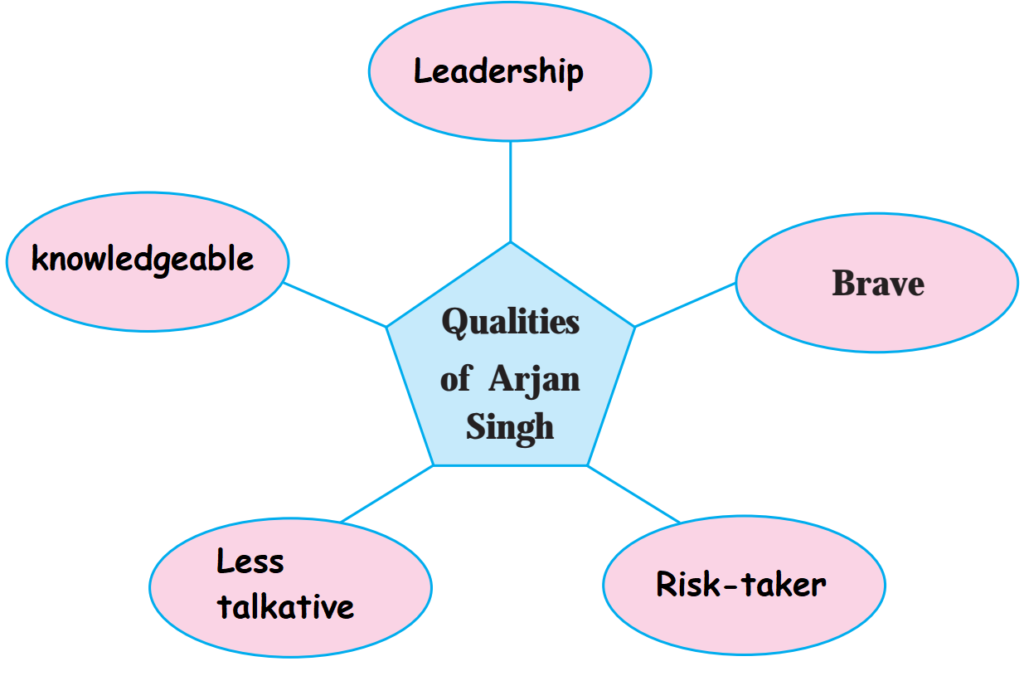
4. Say what actions preceded the following promotions of Arjan Singh in his career in the IAF.
(i) Selected for Empire Pilot training course at RAF
Ans. Arjan Singh completed his education at Montogomery.
(ii) Promoted to Squadron Leader
Ans. Arjan Singh flew against the tribal forces.
(iii) Leader of a flypast over 100 aircrafts at Red Fort, Delhi.
Ans. Arjan Singh successfully led the squadron in combat.
(iv) Awarded Padma Vibhushan
Ans. Arjan Singh displayed his astute leadership during the war of the Air Force.
(v) First Air Chief Marshal of Indian Air Force.
Ans. Air Force contributed during the war and the rank of the CAS was upgraded.
5. Replace the underlined words/phrases with the appropriate ones, to retain the proper meaning.
(be the epitome of, gear up, a brief stint, play a major role, in recognition of, take over reins)
(a) He contributed notably in bringing up the school.
(b) Our school cricket team got ready for the final match against P. Q. R. High School.
(c) After a short period of working as a lecturer, Ravi took up an important post in a multi-national company.
(d) Our class monitor is a perfect symbol of duty and discipline.
(e) Accepting the great value of his research; they awarded him with a Ph.D. (degree)
(f) After the murder of King Duncan, Macbeth took over the control of Scotland.
Ans.
(a) He played a major role in bringing up the school.
(b) Our school cricket team geared up for the final match against P.Q.R High School.
(c) After a brief stint as a lecturer, Ravi took up an important post in a multi-national company.
(d) Our class monitor is the epitome of duty and discipline.
(e) In recognition of his reasearch, they awarded him with a Ph.d. (degree)
(f) After the murder of King Duncan, Macbeth took over reigns of Scotland.
6. Build the word wall with the words related to ‘Military’.

Ans.
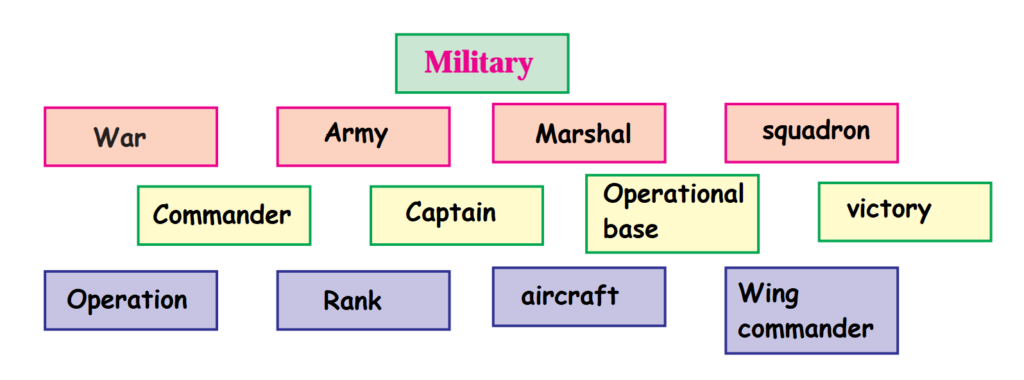
7. (A) State the different meanings of the following pairs of Homophones and make sentences of your own with each of them.

Ans.
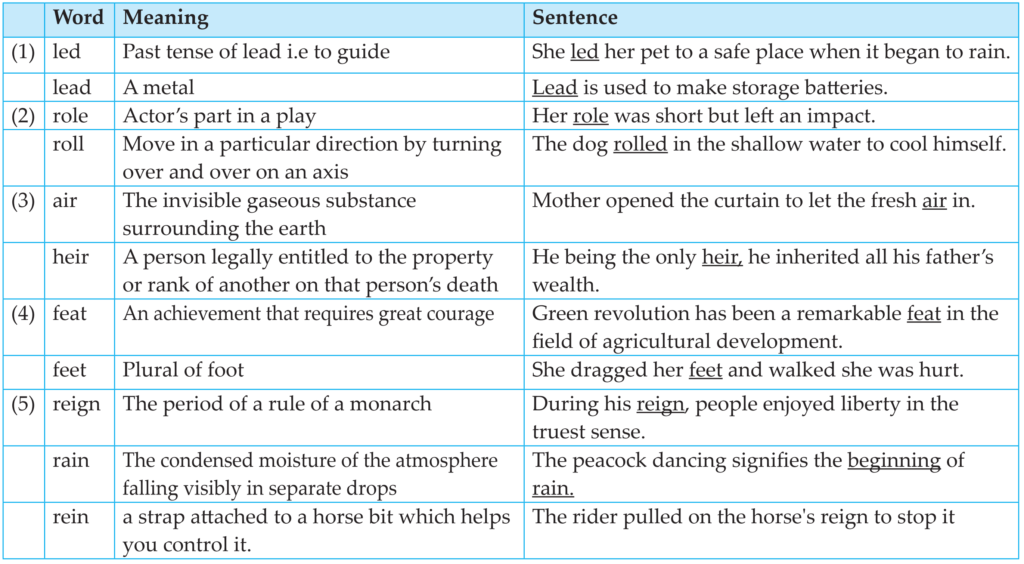
(B) The following Homographs have the same spelling and pronunciation; but can have different meanings. Make sentences of your own to show the difference.
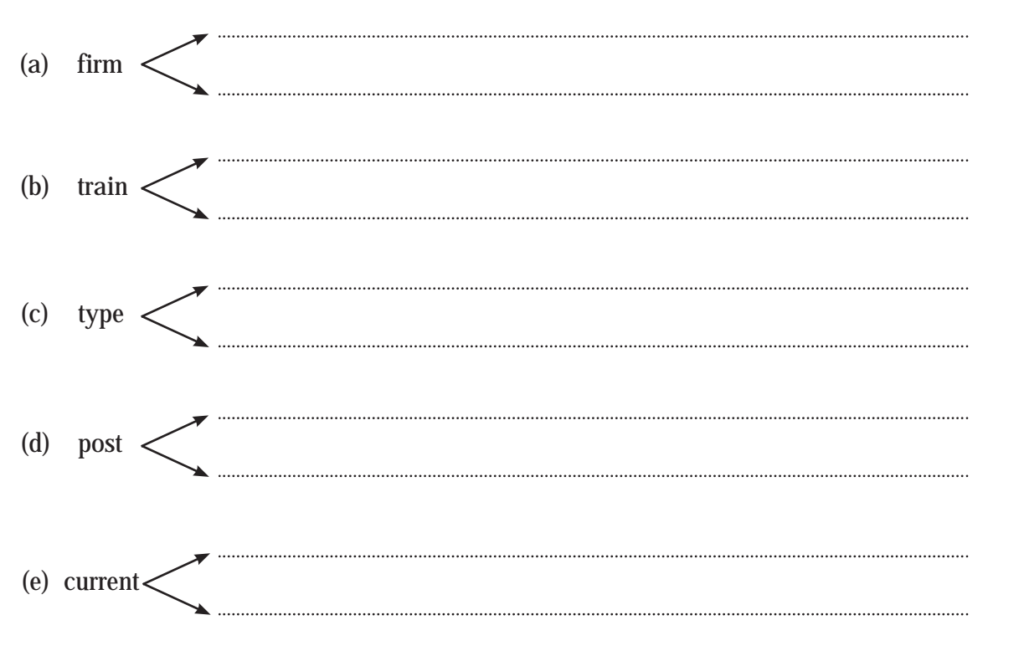
Ans.
(i) firm
(a) He started his own firm at 25.
(b) The teacher decided to be firm with the naughty kids
(ii) train
(a) The train starts from Kolhapur
(b) I train students to communicate with confidence.
(iii) type
(a) Type the letter and post it today
(b) Ragging is a type of harassment.
(iv) post
(a) She held the post of the Principal for 20 years.
(b) Anil will post the message on the group
(v) current
(a) Today the current situation of our country is unrest.
(b) It is difficult task to row against the current in a river.
Glance through the text and prepare notes from the information that you get. Take only relevant points. Don’t use sentences. Arrange the points in the same
order. You may use symbols or short forms. Present the points sequentially. Use highlighting techniques.
Ans.
Air Force Marshal Arjan Singh—Icon of India’s Military History
(1) Date of Birth: 15 April. 1919
(2) Qualifications: Empire Pilot Training Course at RAF (Cranwell)
(3) Responsibilities:
⇒ first assignment to fly Westland Wapiti biplanes in No. 1 RIAF Squadron
⇒ brief stint in No. 2 RIAF Squadron: moved back to No. 1 RIAF Squadron as Flying Officer
⇒ overall commander of ‘Shiksha’
⇒ led the IAF during the 1965 Indo-Pak war
⇒ led a squadron against the Japanese during the Arakan Campaign: assisted the advance of Allied Forces to Yangoon
⇒ led a fly-past on August 15, 1947
⇒ commanded Ambala in the rank of Group Captain: look over as AOC of an operational command
⇒ took over reins of the IAF
⇒ ambassador to Switzerland; Lieutenant Governor of Delhi
(4) Achievements:
⇒ selected for the Empire Pilot Training Course at RAF (Cranwell) in 1938, at age 19
⇒ promoted to the rank of Squadron Leader in 1944
⇒ led a fly-past over the Red Fort on August 15, 1947
⇒ promoted to the rank of Wing Commander: promoted to the rank of Air Commodore In 1949
⇒ longest tenure as AOC (1949-1952 and 1957-1961)
⇒ appointed as Deputy Chief of Air Staff at the end of the 1962 war: appointed as Vice Chief of Air Staff in 1963
⇒ rank of Air Marshal In August 1964: took over reins of IAF
⇒ successfully led the IAF In 1965 Indo-Pak war
⇒ promoted as Air Vice Marshal: appointed as AOC-in-C of an operational command
⇒ first Air Chief to keep his flying currency till his CAS rank: has flown more than 60 different types of aircraft
⇒ first and only Air Chief Marshal of the IAF
(5) Awards :
⇒ Distinguished Flying Cross (1944)
⇒ Padma Vibhushan
(6) After retirement :
⇒ Ambassador to Switzerland; Lieutenant Governor of Delhi.
9. Develop a story suitable to the conclusion/end given below. Suggest a suitable title.
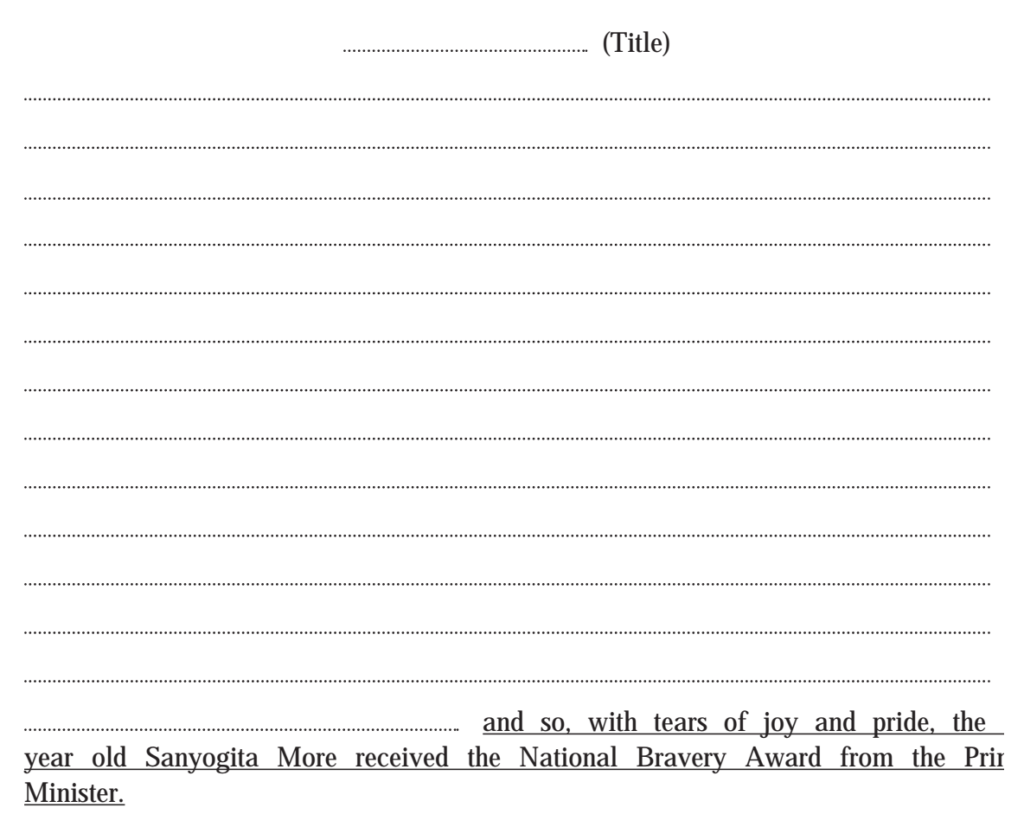
Ans.
Little hands, Great deeds
In a far corner of Achalpur Village lived a happy family of four. A small field of maize was worked upon by the hardworking hands of Vilasrao More and his wife Sushobhana. They were blessed with a beautiful and intelligent daughter Sanyogita and an equally bright son, Sahil. Playing in the maize fields when the parents worked was the only past time for the children Ten year old Sanyogita, studied in grade 5 while Sahil was a grade 2 student. School being far, they had to be dropped and picked up. However, on days when Vilasrao couldn’t make it, the siblings walked their way home enjoying some freedom.
On one such day, when Vilasrao had to go to the city market to sell his yield mother informed Sanyogita, “Take care of Sahil and do not loiter about. Come home straight. I shall be making your favourite Puranpolis today.” Sanyogita’s faceit up as she chuckled, Really Aai., You are the best Aai in the whole world.” “Okay, okay, I know that. You have to be the best sister and a very good girl today.” said Sushobhana.
Off they went to school. By evening, they were tired of all the studies and play. Little feet dragged them home words, The pace fastened at the thought of hot Puran Polis served by mother. Sahil was too hungry to get home. He looked appallingly at the elder sister. He knew she had a 5 rupee coin in her pocket father had given her the day before. Sanyogita searched for the coin and taking Sahil by the hand bought some roasted peanuts. But as she turned her back, an acrid smell caught her attention. The air was heavy with it. Before she could think, cries of help from a hearby roadside house alarmed her.
The brother – sister pair rushed to see a woman and her two year old lying unconscious while others wailed for help. The peanut seller fell numb. It was his wife and baby. Sanyogita had no time to think. She immediately handed over Sahil to the shopkeeper and leapt to see the source of fire. A four feet flame coming from an oil lamp engulfed the kitchen. She filled a bucket with mud and doused the fire by pouring mud over it. Next was the gas cylinder that had caught fire.
She cried, “Pass that sack, Kaka.” The shopkeeper threw the sack at her and she could extinguish the fire before the cylinder had a chance to explode. Sahil stood their clapping and
motivating his elder sister. People were shocked to see a 10 year old put an end to a disaster with her presence of mind. After the woman and her baby gained consciousness, she took leave from the ever so grateful peanut seller. Happy at being helpful, Sanyogita was scared that mother would scold her for being late. She kept the incident from mother after reaching home. The excited Sahil was stopped by Sanyogita’s threatening glare. Both relished Puran Polis and went off to sleep.
The next day the Sarpanch paid a visit to Vilasrao’s humble home and narrated the incident. Vilas and Sushobhana were worried and happy at the same time. When Sanyogita
returned from school, they enquired about the incident. A happy and excited Sahil enacted the dare devilry of his elder sister.
On 26th January, Sanyogita accompanied by her parents and brother went off to New Delhi. She was amongst the 24 children who posed with the Prime Minister. T.V. cameras surrounded her when her name was called out and so with tears of joy and pride the 10 year old Sanyogita More received the National Bravery Award from the Prime Minister.
10. You wish to join any one of the Indian Armed Forces. Fill in the following application form.
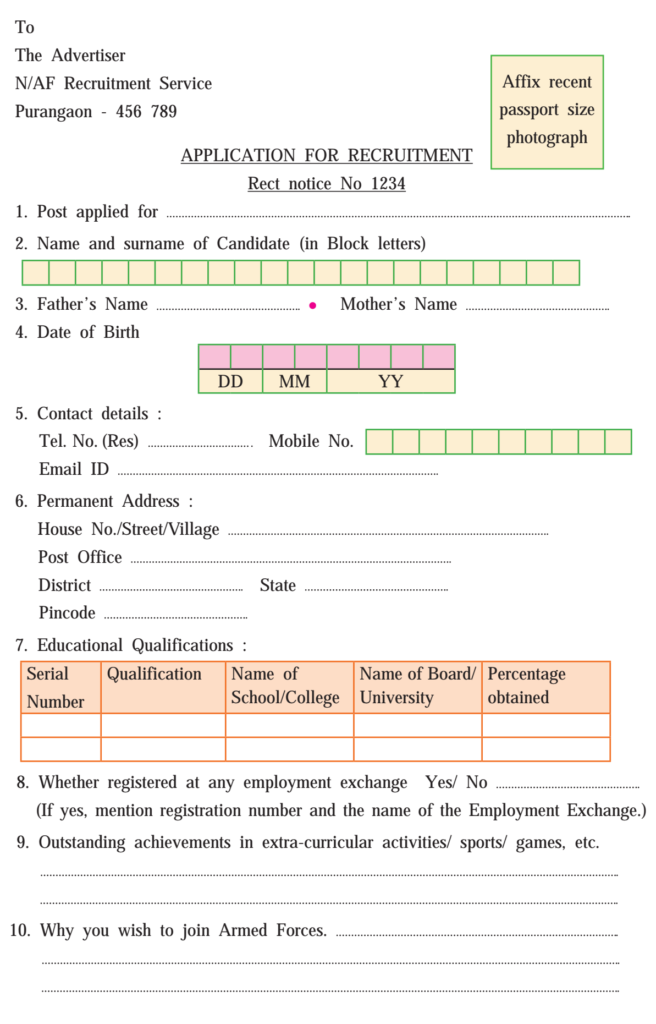
Ans.
